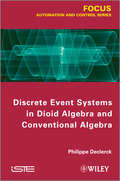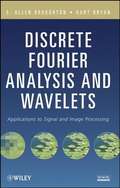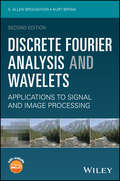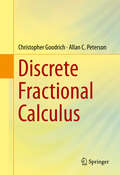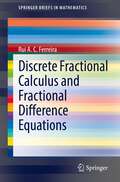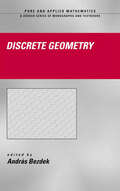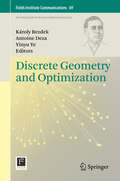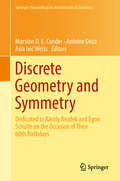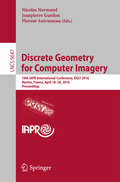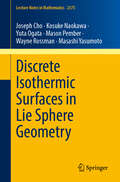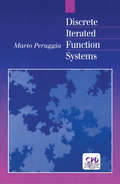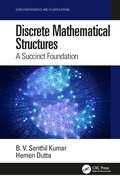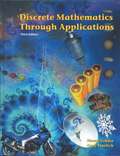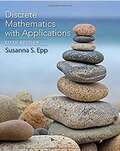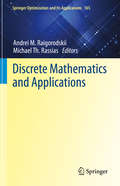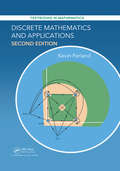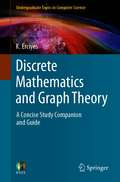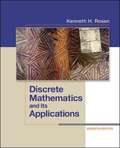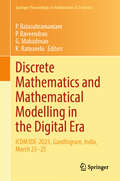- Table View
- List View
Discrete Event Simulation for Health Technology Assessment
by J. Jaime Caro Jörgen Möller Jonathan Karnon James Stahl Jack IshakThis is the first book to make all the central concepts of discrete event simulation relevant for health technology assessment. Accessible to beginners, the book requires no prerequisites and describes the concepts with as little jargon as possible. It presents essential concepts, a fully worked out implementation example, approaches to analyze the simulations, the development of the required equations, model verification techniques, and validation. The book also covers various special topics and includes a real case study involving screening strategies for breast cancer surveillance.
Discrete Event Systems in Dioid Algebra and Conventional Algebra (Focus Ser.)
by Philippe DeclerckThis book concerns the use of dioid algebra as (max, +) algebra to treat the synchronization of tasks expressed by the maximum of the ends of the tasks conditioning the beginning of another task – a criterion of linear programming. A classical example is the departure time of a train which should wait for the arrival of other trains in order to allow for the changeover of passengers. The content focuses on the modeling of a class of dynamic systems usually called “discrete event systems” where the timing of the events is crucial. Events are viewed as sudden changes in a process which is, essentially, a man-made system, such as automated manufacturing lines or transportation systems. Its main advantage is its formalism which allows us to clearly describe complex notions and the possibilities to transpose theoretical results between dioids and practical applications.
Discrete Fourier Analysis and Wavelets
by S. Allen Broughton Kurt M. BryanA thorough guide to the classical and contemporary mathematical methods of modern signal and image processingDiscrete Fourier Analysis and Wavelets presents a thorough introduction to the mathematical foundations of signal and image processing. Key concepts and applications are addressed in a thought-provoking manner and are implemented using vector, matrix, and linear algebra methods. With a balanced focus on mathematical theory and computational techniques, this self-contained book equips readers with the essential knowledge needed to transition smoothly from mathematical models to practical digital data applications.The book first establishes a complete vector space and matrix framework for analyzing signals and images. Classical methods such as the discrete Fourier transform, the discrete cosine transform, and their application to JPEG compression are outlined followed by coverage of the Fourier series and the general theory of inner product spaces and orthogonal bases. The book then addresses convolution, filtering, and windowing techniques for signals and images. Finally, modern approaches are introduced, including wavelets and the theory of filter banks as a means of understanding the multiscale localized analysis underlying the JPEG 2000 compression standard.Throughout the book, examples using image compression demonstrate how mathematical theory translates into application. Additional applications such as progressive transmission of images, image denoising, spectrographic analysis, and edge detection are discussed. Each chapter provides a series of exercises as well as a MATLAB project that allows readers to apply mathematical concepts to solving real problems. Additional MATLAB routines are available via the book's related Web site.With its insightful treatment of the underlying mathematics in image compression and signal processing, Discrete Fourier Analysis and Wavelets is an ideal book for mathematics, engineering, and computer science courses at the upper-undergraduate and beginning graduate levels. It is also a valuable resource for mathematicians, engineers, and other practitioners who would like to learn more about the relevance of mathematics in digital data processing.
Discrete Fourier Analysis and Wavelets: Applications to Signal and Image Processing
by S. Allen Broughton Kurt BryanDelivers an appropriate mix of theory and applications to help readers understand the process and problems of image and signal analysisMaintaining a comprehensive and accessible treatment of the concepts, methods, and applications of signal and image data transformation, this Second Edition of Discrete Fourier Analysis and Wavelets: Applications to Signal and Image Processing features updated and revised coverage throughout with an emphasis on key and recent developments in the field of signal and image processing. Topical coverage includes: vector spaces, signals, and images; the discrete Fourier transform; the discrete cosine transform; convolution and filtering; windowing and localization; spectrograms; frames; filter banks; lifting schemes; and wavelets. Discrete Fourier Analysis and Wavelets introduces a new chapter on frames—a new technology in which signals, images, and other data are redundantly measured. This redundancy allows for more sophisticated signal analysis. The new coverage also expands upon the discussion on spectrograms using a frames approach. In addition, the book includes a new chapter on lifting schemes for wavelets and provides a variation on the original low-pass/high-pass filter bank approach to the design and implementation of wavelets. These new chapters also include appropriate exercises and MATLAB® projects for further experimentation and practice. • Features updated and revised content throughout, continues to emphasize discreteand digital methods, and utilizes MATLAB® to illustrate these concepts • Contains two new chapters on frames and lifting schemes, which take into account crucial new advances in the field of signal and image processing • Expands the discussion on spectrograms using a frames approach, which is an ideal method for reconstructing signals after information has been lost or corrupted (packet erasure) • Maintains a comprehensive treatment of linear signal processing for audio and image signals with a well-balanced and accessible selection of topics that appeal to a diverse audience within mathematics and engineering • Focuses on the underlying mathematics, especially the concepts of finite-dimensional vector spaces and matrix methods, and provides a rigorous model for signals and images based on vector spaces and linear algebra methods • Supplemented with a companion website containing solution sets and software exploration support for MATLAB and SciPy (Scientific Python) Thoroughly class-tested over the past fifteen years, Discrete Fourier Analysis and Wavelets: Applications to Signal and Image Processing is an appropriately self-contained book ideal for a one-semester course on the subject.S. Allen Broughton, PhD, is Professor Emeritus of Mathematics at Rose-Hulman Institute of Technology. Dr. Broughton is a member of the American Mathematical Society (AMS) and the Society for the Industrial Applications of Mathematics (SIAM), and his research interests include the mathematics of image and signal processing, and wavelets. Kurt Bryan, PhD, is Professor of Mathematics at Rose-Hulman Institute of Technology. Dr. Bryanis a member of MAA and SIAM and has authored over twenty peer-reviewed journal articles. Kurt Bryan, PhD, is Professor of Mathematics at Rose-Hulman Institute of Technology. Dr. Bryanis a member of MAA and SIAM and has authored over twenty peer-reviewed journal articles.Maintaining a comprehensive and accessible treatment of the concepts, methods, and applications of signal and image data transformation, this Second Edition of Discrete Fourier Analysis and Wavelets: Applications to Signal and Image Processing features updated and r
Discrete Fractional Calculus
by Christopher Goodrich Allan C. PetersonThis text provides the first comprehensive treatment of the discrete fractional calculus. Experienced researchers will find the text useful as a reference for discrete fractional calculus and topics of current interest. Students who are interested in learning about discrete fractional calculus will find this text to provide a useful starting point. Several exercises are offered at the end of each chapter and select answers have been provided at the end of the book. The presentation of the content is designed to give ample flexibility for potential use in a myriad of courses and for independent study. The novel approach taken by the authors includes a simultaneous treatment of the fractional- and integer-order difference calculus (on a variety of time scales, including both the usual forward and backwards difference operators). The reader will acquire a solid foundation in the classical topics of the discrete calculus while being introduced to exciting recent developments, bringing them to the frontiers of the subject. Most chapters may be covered or omitted, depending upon the background of the student. For example, the text may be used as a primary reference in an introductory course for difference equations which also includes discrete fractional calculus. Chapters 1--2 provide a basic introduction to the delta calculus including fractional calculus on the set of integers. For courses where students already have background in elementary real analysis, Chapters 1--2 may be covered quickly and readers may then skip to Chapters 6--7 which present some basic results in fractional boundary value problems (FBVPs). Chapters 6--7 in conjunction with some of the current literature listed in the Bibliography can provide a basis for a seminar in the current theory of FBVPs. For a two-semester course, Chapters 1--5 may be covered in depth, providing a very thorough introduction to both the discrete fractional calculus as well as the integer-order calculus.
Discrete Fractional Calculus and Fractional Difference Equations (SpringerBriefs in Mathematics)
by Rui A. FerreiraThis brief aims to merge the theories of fractional calculus and discrete calculus in a concise but comprehensive manner. It is designed for graduate students, but will be useful for any researcher interested in the theory of discrete fractional calculus and fractional difference equations.
Discrete Geometry (Chapman & Hall/CRC Pure and Applied Mathematics)
by Andras BezdekCelebrating the work of Professor W. Kuperberg, this reference explores packing and covering theory, tilings, combinatorial and computational geometry, and convexity, featuring an extensive collection of problems compiled at the Discrete Geometry Special Session of the American Mathematical Society in New Orleans, Louisiana. Discrete Geometry analy
Discrete Geometry and Mathematical Morphology: Third International Joint Conference, DGMM 2024, Florence, Italy, April 15–18, 2024, Proceedings (Lecture Notes in Computer Science #14605)
by Andrea Frosini Simone Rinaldi Sara BrunettiThis book constitutes the refereed proceedings of the Third International Joint Conference on Discrete Geometry and Mathematical Morphology, DGMM 2024, held in Florence, Italy during April 15–18, 2024. The 34 full papers included in this book were carefully reviewed and selected from 51 submissions. They were organized in topical sections as follows: Digital Geometry - Models, Transforms, and Visualization; Computational Aspects of Discrete Structures and Tilings; Learning Based Morphology; Hierarchical and Graph-Based Models, Analysis and Segmentation; Discrete and Combinatorial Topology; and Mathematical Morphology and Digital Geometry for Applications.
Discrete Geometry and Optimization
by Yinyu Ye Antoine Deza Karoly BezdekOptimization has long been a source of both inspiration and applications for geometers, and conversely, discrete and convex geometry have provided the foundations for many optimization techniques, leading to a rich interplay between these subjects. The purpose of the Workshop on Discrete Geometry, the Conference on Discrete Geometry and Optimization, and the Workshop on Optimization, held in September 2011 at the Fields Institute, Toronto, was to further stimulate the interaction between geometers and optimizers. This volume reflects the interplay between these areas. The inspiring Fejes Tóth Lecture Series, delivered by Thomas Hales of the University of Pittsburgh, exemplified this approach. While these fields have recently witnessed a lot of activity and successes, many questions remain open. For example, Fields medalist Stephen Smale stated that the question of the existence of a strongly polynomial time algorithm for linear optimization is one of the most important unsolved problems at the beginning of the 21st century. The broad range of topics covered in this volume demonstrates the many recent and fruitful connections between different approaches, and features novel results and state-of-the-art surveys as well as open problems.
Discrete Geometry and Symmetry: Dedicated to Károly Bezdek and Egon Schulte on the Occasion of Their 60th Birthdays (Springer Proceedings in Mathematics & Statistics #234)
by Antoine Deza Asia Ivić Weiss Marston D. ConderThis book consists of contributions from experts, presenting a fruitful interplay between different approaches to discrete geometry. Most of the chapters were collected at the conference “Geometry and Symmetry” in Veszprém, Hungary from 29 June to 3 July 2015. The conference was dedicated to Károly Bezdek and Egon Schulte on the occasion of their 60th birthdays, acknowledging their highly regarded contributions in these fields.While the classical problems of discrete geometry have a strong connection to geometric analysis, coding theory, symmetry groups, and number theory, their connection to combinatorics and optimization has become of particular importance. The last decades have seen a revival of interest in discrete geometric structures and their symmetry. The rapid development of abstract polytope theory has resulted in a rich theory featuring an attractive interplay of methods and tools from discrete geometry, group theory and geometry, combinatorial group theory, and hyperbolic geometry and topology. This book contains papers on new developments in these areas, including convex and abstract polytopes and their recent generalizations, tiling and packing, zonotopes, isoperimetric inequalities, and on the geometric and combinatorial aspects of linear optimization. The book is a valuable resource for researchers, both junior and senior, in the field of discrete geometry, combinatorics, or discrete optimization. Graduate students find state-of-the-art surveys and an open problem collection.
Discrete Geometry for Computer Imagery
by Nicolas Normand Jeanpierre Guédon Florent AutrusseauThisbook constitutes the refereed proceedings of the 19th IAPR InternationalConference on Discrete Geometry for Computer Imagery, DGCI 2016, held in Nantes,France, in April 2016. The 32 revised full papers presented together with 2invited talks were carefully selected from 51 submissions. The papers areorganized in topical sections on combinatorial tools; discretization; discretetomography; discrete and combinatorial topology; shape descriptors; models fordiscrete geometry; circle drawing; morphological analysis; geometrictransforms; and discrete shape representation, recognition and analysis.
Discrete Harmonic Analysis: Representations, Number Theory, Expanders, and the Fourier Transform (Cambridge Studies in Advanced Mathematics #172)
by Tullio Ceccherini-Silberstein Fabio Scarabotti Filippo TolliThis self-contained book introduces readers to discrete harmonic analysis with an emphasis on the Discrete Fourier Transform and the Fast Fourier Transform on finite groups and finite fields, as well as their noncommutative versions. It also features applications to number theory, graph theory, and representation theory of finite groups. Beginning with elementary material on algebra and number theory, the book then delves into advanced topics from the frontiers of current research, including spectral analysis of the DFT, spectral graph theory and expanders, representation theory of finite groups and multiplicity-free triples, Tao's uncertainty principle for cyclic groups, harmonic analysis on GL(2,Fq), and applications of the Heisenberg group to DFT and FFT. With numerous examples, figures, and over 160 exercises to aid understanding, this book will be a valuable reference for graduate students and researchers in mathematics, engineering, and computer science.
Discrete Isothermic Surfaces in Lie Sphere Geometry (Lecture Notes in Mathematics #2375)
by Joseph Cho Kosuke Naokawa Yuta Ogata Mason Pember Wayne Rossman Masashi YasumotoThis book provides a highly accessible approach to discrete surface theory, within the unifying frameworks of Moebius and Lie sphere geometries, from the perspective of transformation theory of surfaces rooted in integrable systems. It elucidates how the transformation theory for smooth surfaces can be used as a springboard for understanding the discretization process of certain types of surfaces, and it is aimed at high-level undergraduate students, graduate students and professional mathematicians alike. The reader will benefit from the detailed exploration of the transformation theory of surfaces, including Christoffel, Calapso and Darboux transformations of particular classes of surfaces, as well as becoming more familiar with integrable systems via zero curvature representation, including flat connections and conserved quantities, in both smooth and discrete settings.
Discrete Iterated Function Systems
by Mario PeruggiaWritten for researchers and developers applying Integrated Function Systems in the creation of fractal images, this book presents a modification of a widely used probabilistic algorithm for generating IFS-encoded images. The book also includes a discussion of how IFS techniques can be applied to produce animated motion pictures.
Discrete Mathematical Models in Population Biology: Ecological, Epidemic, and Evolutionary Dynamics (Springer Undergraduate Texts in Mathematics and Technology)
by Jim M. Cushing Saber N. ElaydiThis text lays the foundation for understanding the beauty and power of discrete-time models. It covers rich mathematical modeling landscapes, each offering deep insights into the dynamics of biological systems. A harmonious balance is achieved between theoretical principles, mathematical rigor, and practical applications. Illustrative examples, numerical simulations, and empirical case studies are provided to enhance mastery of the subject and facilitate the translation of discrete-time mathematical biology into real-world challenges. Mainly geared to upper undergraduates, the text may also be used in graduate courses focusing on discrete-time modeling. Chapters 1–4 constitute the core of the text. Instructors will find the dependence chart quite useful when designing their particular course. This invaluable resource begins with an exploration of single-species models where frameworks for discrete-time modeling are established. Competition models and Predator-prey interactions are examined next followed by evolutionary models, structured population models, and models of infectious diseases. The consequences of periodic variations, seasonal changes, and cyclic environmental factors on population dynamics and ecological interactions are investigated within the realm of periodically forced biological models. This indispensable resource is structured to support educational settings: A first course in biomathematics, introducing students to the fundamental mathematical techniques essential for biological research. A modeling course with a concentration on developing and analyzing mathematical models that encapsulate biological phenomena. An advanced mathematical biology course that offers an in-depth exploration of complex models and sophisticated mathematical frameworks designed to tackle advanced problems in biology. With its clear exposition and methodical approach, this text educates and inspires students and professionals to apply mathematical biology to real-world situations. While minimal knowledge of calculus is required, the reader should have a solid mathematical background in linear algebra.
Discrete Mathematical Structures: A Succinct Foundation (Mathematics and its Applications)
by Hemen Dutta B. V. KumarThis book contains fundamental concepts on discrete mathematical structures in an easy to understand style so that the reader can grasp the contents and explanation easily. The concepts of discrete mathematical structures have application to computer science, engineering and information technology including in coding techniques, switching circuits, pointers and linked allocation, error corrections, as well as in data networking, Chemistry, Biology and many other scientific areas. The book is for undergraduate and graduate levels learners and educators associated with various courses and progammes in Mathematics, Computer Science, Engineering and Information Technology. The book should serve as a text and reference guide to many undergraduate and graduate programmes offered by many institutions including colleges and universities. Readers will find solved examples and end of chapter exercises to enhance reader comprehension. Features Offers comprehensive coverage of basic ideas of Logic, Mathematical Induction, Graph Theory, Algebraic Structures and Lattices and Boolean Algebra Provides end of chapter solved examples and practice problems Delivers materials on valid arguments and rules of inference with illustrations Focuses on algebraic structures to enable the reader to work with discrete structures
Discrete Mathematics With Applications
by Susanna S. EppDISCRETE MATHEMATICS WITH APPLICATIONS, 5th Edition, explains complex, abstract concepts with clarity and precision and provides a strong foundation for computer science and upper-level mathematics courses of the computer age. Author Susanna Epp presents not only the major themes of discrete mathematics, but also the reasoning that underlies mathematical thought. <p><p>Students develop the ability to think abstractly as they study the ideas of logic and proof. While learning about such concepts as logic circuits and computer addition, algorithm analysis, recursive thinking, computability, automata, cryptography and combinatorics, students discover that the ideas of discrete mathematics underlie and are essential to today's science and technology.
Discrete Mathematics With Applications
by Susanna S. EppDISCRETE MATHEMATICS WITH APPLICATIONS, 5th Edition, explains complex, abstract concepts with clarity and precision and provides a strong foundation for computer science and upper-level mathematics courses of the computer age. <p><p>Author Susanna Epp presents not only the major themes of discrete mathematics, but also the reasoning that underlies mathematical thought. Students develop the ability to think abstractly as they study the ideas of logic and proof. While learning about such concepts as logic circuits and computer addition, algorithm analysis, recursive thinking, computability, automata, cryptography and combinatorics, students discover that the ideas of discrete mathematics underlie and are essential to today's science and technology.
Discrete Mathematics and Applications (Springer Optimization and Its Applications #165)
by Michael Th. Rassias Andrei M. RaigorodskiiAdvances in discrete mathematics are presented in this book with applications in theoretical mathematics and interdisciplinary research. Each chapter presents new methods and techniques by leading experts. Unifying interdisciplinary applications, problems, and approaches of discrete mathematics, this book connects topics in graph theory, combinatorics, number theory, cryptography, dynamical systems, finance, optimization, and game theory. Graduate students and researchers in optimization, mathematics, computer science, economics, and physics will find the wide range of interdisciplinary topics, methods, and applications covered in this book engaging and useful.
Discrete Mathematics and Applications, Second Edition (Textbooks in Mathematics)
by Kevin FerlandThis book is intended for a one-semester course in discrete mathematics. Such a course is typically taken by mathematics, mathematics education, and computer science majors, usually in their sophomore year. Calculus is not a prerequisite to use this book. Part one focuses on how to write proofs, then moves on to topics in number theory, employing set theory in the process. Part two focuses on computations, combinatorics, graph theory, trees, and algorithms.
Discrete Mathematics and Graph Theory: A Concise Study Companion and Guide (Undergraduate Topics in Computer Science)
by K. ErciyesThis textbook can serve as a comprehensive manual of discrete mathematics and graph theory for non-Computer Science majors; as a reference and study aid for professionals and researchers who have not taken any discrete math course before. It can also be used as a reference book for a course on Discrete Mathematics in Computer Science or Mathematics curricula. The study of discrete mathematics is one of the first courses on curricula in various disciplines such as Computer Science, Mathematics and Engineering education practices. Graphs are key data structures used to represent networks, chemical structures, games etc. and are increasingly used more in various applications such as bioinformatics and the Internet. Graph theory has gone through an unprecedented growth in the last few decades both in terms of theory and implementations; hence it deserves a thorough treatment which is not adequately found in any other contemporary books on discrete mathematics, whereas about 40% of this textbook is devoted to graph theory. The text follows an algorithmic approach for discrete mathematics and graph problems where applicable, to reinforce learning and to show how to implement the concepts in real-world applications.
Discrete Mathematics and Its Applications
by Kenneth H. RosenRosen's Discrete Mathematics and its Applications presents a precise, relevant, comprehensive approach to mathematical concepts. This world-renowned best-selling text was written to accommodate the needs across a variety of majors and departments, including mathematics, computer science, and engineering. As the market leader, the book is highly flexible, comprehensive and a proven pedagogical teaching tool for instructors. Digital is becoming increasingly important and gaining popularity, crowning Connect as the digital leader for this discipline. <p><p>McGraw-Hill Education's Connect, available as an optional, add on item. Connect is the only integrated learning system that empowers students by continuously adapting to deliver precisely what they need, when they need it, how they need it, so that class time is more effective. Connect allows the professor to assign homework, quizzes, and tests easily and automatically grades and records the scores of the student's work. Problems are randomized to prevent sharing of answers and may also have a "multi-step solution" which helps move the students' learning along if they experience difficulty.
Discrete Mathematics and Its Applications Seventh Edition
by Kenneth H. RosenDiscrete Mathematics and Its Applications, Seventh Edition, is intended for one or two term introductory Discrete Mathematics courses taken by students from a wide variety of majors, including Computer Science, Mathematics, and Engineering.
Discrete Mathematics and Mathematical Modelling in the Digital Era: ICDM3DE-2023, Gandhigram, India, March 23–25 (Springer Proceedings in Mathematics & Statistics #458)
by P. Balasubramaniam P. Raveendran G. Mahadevan K. RatnaveluThis book features carefully selected research papers presented during the 9th International Conference on Discrete Mathematics and Mathematical Modelling in the Digital Era (ICDMMMDE-2023). The conference, organised at the Department of Mathematics, The Gandhigram Rural Institute in Gandhigram, Tamil Nadu, India, took place from 23–25 March 2023. Serving as a dynamic platform, the event attracted emerging researchers, mathematicians, industrialists, scientists, and engineers from across the globe, fostering discussions on pertinent research topics. This volume showcases noteworthy contributions from esteemed researchers within the realm of discrete mathematics and mathematical modeling, meticulously subjected to a rigorous peer-review process for publication. The included papers delve into diverse subjects, including controllability, image processing, topology, graph theory, fuzzy delay differential equations, analysis, queuing theory, and applications in networks and biology. Theculmination of these contributions forms a comprehensive and authoritative resource for scholars and professionals alike.

